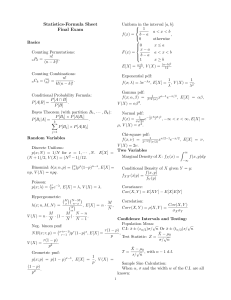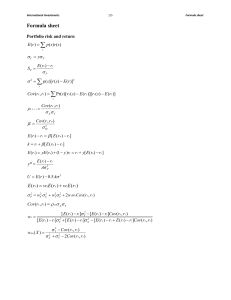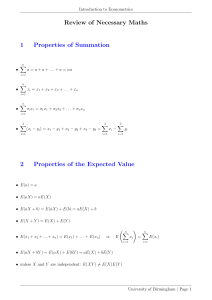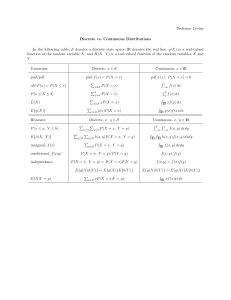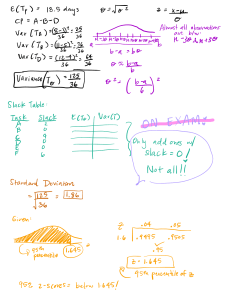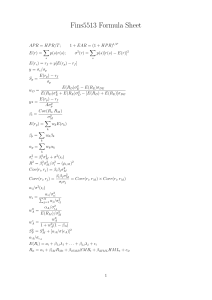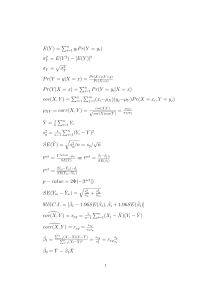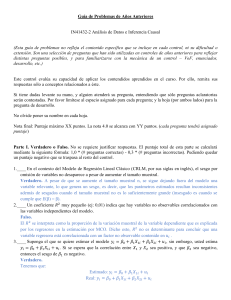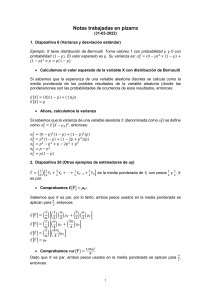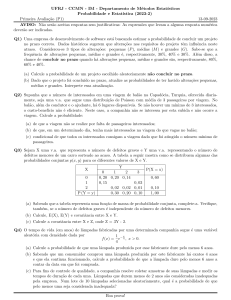Variables Aleatorias Independientes: Covarianza y Correlación
advertisement
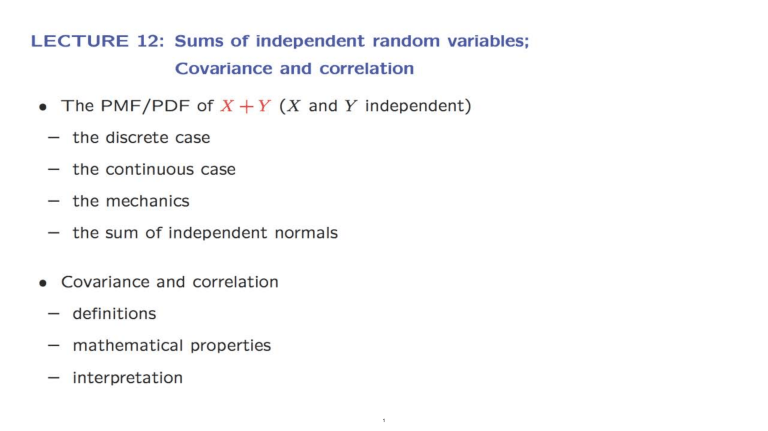
LECTURE 12: Sums of independent random variables;
Covariance and correlation
•
The PMF/PDF of X
+y
eX and Y independent)
the discrete case
the continuous case
the mechanics
the sum of independent normals
•
Covariance and correlation
definitions
mathematical properties
interpretation
1
The distribution of X
• z=
X
+ Y;
the discrete case
x
•
known PMFs
•.•
pz (z) = L PX(x)PY(z ­ x)
X, Y ind epe nd ent , discrete
~()(II')
PZ(3) =
+ Y:
+.f(i<";O,y~;) +.f(x,I,'1',£)-I-'··
f'"
T
•
P.,.
y
•
(0,3 )
• (1.2)
•
:: ~ PI< (x)
(2 , I )
?C­
3.0
•
2
f'( (~-:;d
.'
~.
'1
Discrete convolution mechanics
pz(z) = L Px(x)PY(z - x)
x
PX
py
2/3
'/3
3/6
' /6
• To find pz(3 ):
' /6
3/ 6
' /6
Flip (horizontally) the PMF of Y
' /6
- 2
- 1
,
Put it underneath the PMF of X
3/ 6
' /6
Right-shift the flipped PMF by 3
' /6
Cross-mu ltipl y and add
Repeat for other va lues of
3
Z
The distribution of X
• z=
X
+ Y;
+ Y:
the continuous case
x
X, Y ind e pend ent , continuous
•
known PDFs
\
y
pz ( z) = L PX(x)PY(z - x)
/C onditional on X = x:
,:- t)' ~ Co "570.", t -
:7
<--
fz(z) = J:fx (:;:)fy ( z - x) dx
=::x.+
y
;>
~=
=
'1'+3
f~I1((~ 13) '" -5'(-1-> ))/2-i'~) = rYH (~) = fy (e-3)
fzllJ2-I~)= fy(~-z-)
Joint PDF of Z and X:
)x 2-(?:)'?-);;:' h (~)
f~+~ r:x:)-=f".(x-b)
7'(=(&oo
- ?:)
Loo
From 'joint to the marginal: fz(z)
•
x~?
Same mechanics as in discrete case (flip, shift, etc.)
4
fx,z(x , z) dx
The sum of independent normal r.v.'s
fz(z) = L : fxCx)hCz - x) dx
Z=X + Y
fx Cx ) =
Jz(z) =
1
Vhax
J:
e - (x - ~u x )2 / 2a:-
fxCx)fy(z - x) dx
OO
J
- 00
(a lg ebra)
1
J2;a x
1
exp
{
(x-I'x)
2a;
2
1
} J2;a y
(z - I' x - I' y)'
....
exp
{
-
"
(z-X-I'Y)
2a~
N
The sum of finitely many independent normals is normal
5
2
}
dx
iJ:2~fY.1.
Covariance
•
Definition for general case:
Zero-mean , discrete X and Y
cov(X, Y) =
if independent: E[XY] =
=G[x] f [If J <:. 0
y
".
... "... .. .
. ..
.
.
.
.. . . . - . . .
. .. .. .
. .
.
.
'*
.
.
•
x
..
•
·.. . .
·. .
· '.
· .. .
. . ..
.
E[XY]
'70
E [Y]~l
• independent
cov(X, Y) = 0
(converse is not true)
.
•
.
-
L'v>d 0 ~E[(7\-G[xJ)l t;[Y-G[yl]
y
.
E [~X - E[X]~. iY
E[XY]
x
y
(0, I )
.
<0
(-1 ,0)
( I ,0)
(0 . - 1)
6
Covariance properties
=E[CX- [[;r])~J
o VQr(x) :: £[xfJ -(£0J)%.
cov(X, Y) =
E [(~ -~ ). !(:: -;; E (':])]
cov(X,X)
=E[xr] - E[xt;[yJ]
- E [G[K] 'f]
cov(aX
+ b, Y)
=
.,; £[>rl(] - G['<j £[yJ
'fJ +- [;[x - yJ
(Q55".... e 0 ... eG\""s)
= 1:[(0,)( +h) 'fj = a.f[XY] ~h
~
cov(X, Y
+ ~) = f
Q. Co
rGD= [x] Fry J]
v (x,,()
[x ('(+ 2:-)J
cov(X, Y) = E (XY] - E (X]E(Y]
~r;[xYJ-t-[['X2]" CO.,(K/-r)-!­
~ov()(,~)
7
The variance of a sum of random variables
va r(X 1
+ X2)
=
Ef
(x,
-I-
x: 'L
­
f [)( I + ;>(,1
((X,
-f[X,J)
=E
-
Y
+ (1(2 - f
[~t.]),
:.[ (ir, -[Ix r ])'! + (~2. - f[X1.1Y"
+J- (x,-£[x,])(X2. -f[r11)
~ \/~I'(X,)+V~r(Xl)
8
+i
Cov
(x ,,)X2-)
•
The variance of a sum of random variables
var(X1
+ X2)
var(X 1 +
('Q.\5CA ...
= Var(X1)
... + X n ) =
e 0
t.o<EIQ"'S)
+ Var(X2) + 2cov(X1 , X2)
6[(I(,l- ..• +tr~ )2.1
""
=f Z x.
:2 A; ?(~
1.
•
T
•
(, '::.. I
;·=L) ... ~ /-t....
i. i- j
1-.2,
, -:f I
n
var(X1
+ ... + X n ) = L
i= 1
var(Xi) +
L
{ ( i,j ) : i ,ejl
9
Cov(x;/~.)
COV(Xi , X j )
The Correlation coefficient
•
p(X, Y)
Dimensionless version of covariance:
_
E (X - E [X]) . (Y - E [Y])
"x
- 1
< P<
cov(X, Y)
-
1
•
Measure of the degree of "association" between X and Y
•
Ind ependent
'*
p
= 0, " uncorrelated"
.
(converse is not true)
• Ipi =
•
1
cov(aX
'*
(X - E[X]) = c(Y - E[Y])
+ b, Y) =
a· cov(X, Y)
"Y
( X, X) =
p
v
0\ '!.
(X)
=1
'l­
17"
(linearly related)
p(aX
10
+ b, Y)
=
0\. . CO v
101 I 0",
(X,
(Tv
'r' )
= ~ It" (c>.)
•
F (><,'f)
Proof of key properties of the correlation coefficient
p(X, Y) =
E (X - E [X]) . (Y - E[Y])
ax
•
- 1
ay
<P<
1
A ssum e, for simpl icity, zero means and unit varian ces, so tha t p(X, Y) = E[XY)
E [(X _ py)2] =
Ipi =
1- J. P £[111 J t Ft E ['12.J
= I -2f~+ft.",.
o!::
If
E [Ki
1 , th en
X =f
'(
~ X
/- f~
='(
11
0 r
1_(".t;>_O - :;pl.S/
X
=- r
Interpreting the correlation coefficient
•
p(X, Y)
_
cov(X, Y)
aXay
Association does not imply causation or influence
X: math aptitude
Y: musical ability
•
Correlation often reflects underlying, common, hidden factor
f
Assume , Z, V, Ware independent
I
(X, Y) =- -J.2: -Vi ~
I
z-'
X= Z +V
--
Assume, for simplicity, that Z, V, W have zero means, unit variances
0> = vi,
Vo.r(x)=vo.l'(?)tVClr(v)::.1 =" 0"''2:,::.V2.
COli (X)y) =-1;[(6 + v)(Z of w>J = I; [6 2
I {;' [v~] + F
J
o
= J..
12
f6 WJ t
o
+-
J
£[vw
0
Correlations matter...
•
A real-estate investment company invests $10M in each of 10 states.
At each state i , the return on its investment is a random variable X i .
with mean 1 and standard deviation 1.3 (in millions).
10
var(X 1 + ... + X lO ) =
L
i= 1
•
L
var(Xi ) +
cov(X i , X j )
E[>(J-+ ..... X,.]:.IO
(i.j ): i", j }
If the X i are uncorrelated. then:
var(X1 + ... +XlO) =
•
) O· ( I.~
) 2.
::::
I
O,O'(X1+"'+ X lO) =
6.)
p
~ 9:
Co V (X',') Xi);:
O'X(
"')
r
2.
V~r(X, 4­
f"J' ::10'\"0,) +l)O.I.52=15''7
If for i
i= j ,
p(Xi, X j ) =
13
'-1./
&;;:: 0 ~"I.~ 1'/.'3,
= 1.5'2­
MIT OpenCourseWare
https://ocw.mit.edu
Resource: Introduction to Probability
John Tsitsiklis and Patrick Jaillet
The following may not correspond to a particular course on MIT OpenCourseWare, but has been provided by the author as an individual learning resource.
For information about citing these materials or our Terms of Use, visit: https://ocw.mit.edu/terms.

